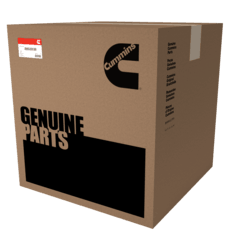This truck part is made by Cummins®. We guarantee that all of our parts are from the OEM (original equipment manufacturer), ensuring a proper fit and quality manufacturing.
We honor the warranty provided by the original equipment manufacturer.
The Scavenge Inlet Tube, identified by Part #202603, is a component manufactured by Cummins, a well-established name in the automotive industry. This Cummins part is integral to the operation of heavy-duty truck engines, facilitating efficient scavenging processes that contribute to overall engine performance.
Function and Operation
The Scavenge Inlet Tube operates within the engine system by directing scavenge air into the engine’s crankcase. This process helps in removing unwanted gases and contaminants that accumulate during engine operation. The tube interacts with the scavenging pump and other engine components to ensure a smooth flow of air, which is vital for maintaining engine health and efficiency 1.
Purpose of the Scavenge Inlet Tube
This part plays a specific role in the operation of a truck by ensuring that the engine’s crankcase remains free of contaminants. This contributes to engine efficiency and performance by maintaining optimal pressure levels and ensuring that the engine operates within its designed parameters 2.
Key Features
The design of the Scavenge Inlet Tube incorporates several characteristics that enhance its functionality. It is constructed from durable materials that can withstand the high temperatures and pressures present in heavy-duty truck engines. The tube’s design allows for efficient air flow, and it is engineered to fit seamlessly within the engine system, ensuring compatibility with other components 3.
Benefits
The Scavenge Inlet Tube offers several advantages. It contributes to improved engine performance by ensuring that the scavenging process is efficient. This can lead to increased durability of the engine components and enhanced fuel efficiency, as the engine operates more smoothly and with fewer contaminants 4.
Installation Process
Installing the Scavenge Inlet Tube requires careful attention to detail. The process involves ensuring that the engine is cool and that all necessary tools are on hand. The tube should be aligned with the scavenging pump and secured in place according to the manufacturer’s instructions. It is important to check for any leaks or irregularities after installation to ensure that the tube is functioning correctly.
Common Issues and Troubleshooting
Typical problems associated with the Scavenge Inlet Tube may include blockages or leaks. These issues can often be identified through routine inspections and maintenance checks. Troubleshooting steps may involve cleaning the tube, checking for proper alignment, or replacing the tube if it is damaged.
Maintenance Tips
To ensure the longevity and optimal performance of the Scavenge Inlet Tube, routine maintenance is recommended. This includes regular inspections for signs of wear or damage, ensuring that the tube is securely fitted, and cleaning the tube as necessary to prevent blockages. Following the manufacturer’s maintenance guidelines will help in maintaining the tube’s efficiency.
Cummins Overview
Cummins has a long-standing reputation in the manufacturing of automotive components. The company’s history is marked by a commitment to quality and innovation, making it a trusted name in the industry. Cummins’ expertise in engine components is evident in the design and functionality of parts like the Scavenge Inlet Tube, which are engineered to meet the demanding requirements of heavy-duty truck engines.
Role of Part 202603 Scavenge Inlet Tube in Engine Systems
The Scavenge Inlet Tube, identified as part 202603, is a component in the efficient operation of various engine systems. Its primary function is to facilitate the return of scavenged oil from the Oil Pan back into the engine’s lubrication system.
In the context of the Oil Pan, the Scavenge Inlet Tube ensures that oil that has accumulated at the bottom of the pan, often due to gravity and engine operation, is effectively drawn back into circulation. This process is vital for maintaining consistent oil levels and pressure within the engine, which in turn supports the lubrication of moving parts, reduces friction, and enhances overall engine performance and longevity.
The tube’s design and placement are engineered to optimize the flow of oil, ensuring that it is efficiently returned to the sump or another designated collection point within the lubrication system. This continuous circulation is key to dissipating heat, removing contaminants, and ensuring that all engine components receive the necessary lubrication to operate smoothly.
Furthermore, the Scavenge Inlet Tube plays a role in the engine’s oil management system by helping to regulate oil temperature and viscosity. By ensuring a steady flow of oil back into the system, it assists in maintaining the oil’s optimal properties for lubrication and cooling, which is particularly important under high-stress conditions or during extended operation.
Conclusion
In summary, the Scavenge Inlet Tube is a fundamental component in the engine’s oil circulation system, working in conjunction with the Oil Pan to ensure efficient oil return, consistent lubrication, and effective heat management.
-
Rajamani, Rajesh. Vehicle Dynamics and Control. Springer, 2005.
↩ -
Pacejka, Hans B. Tyre and Vehicle Dynamics. Butterworth-Heinemann, 2006.
↩ -
Dixon, John C. Tyres Suspension and Handling Second Edition. SAE International, 1996.
↩ -
Denton, Tom, and Hayley Pells. Automotive Technician Training Theory. Routledge, 2022.
↩
SPECIFICATIONS
RECOMMENDED PARTS
* Variable geometry turbocharger and electronic actuator repairs are not eligible to be claimed as over-the-counter under New or ReCon parts warranty for parts installed after October 1, 2018.
* Diesel Oxidation Catalyst (DOC), Diesel Particulate Filter (DPF), Selective Catalyst Reduction (SCR) catalyst, and Electronic Control Module (ECM) repairs are not eligible to be claimed as over-the-counter under New or ReCon parts warranty for parts installed after January 1, 2020.
* These restrictions are only applicable to New parts and ReCon parts coverages for the components listed above sold to a customer in the US or Canada. All other coverages are excluded. All other regions are excluded.

